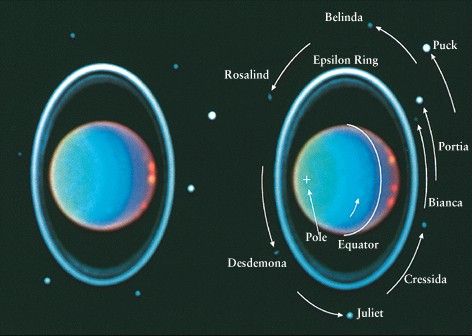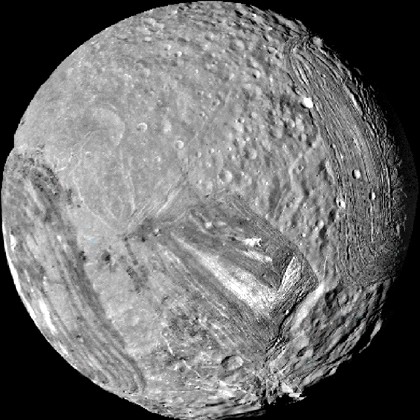Uranus
and Neptune Rings, Moons, Pluto/Charon
Printable
version
April
27, 2000
Announcements
Uranus
and Neptune Rings and Moons, Pluto/Charon Preview
-
Jupiter,
Saturn, Uranus, Neptune, Pluto
-
Uranus's
rings
-
Neptune's
rings
-
Uranus's
satellites
-
Neptune's
main moon Triton
-
Triton's
retrograde orbit
-
Pluto
-
moon
Charon nearly as large
Uranus's
Rings
-
Rings
discovered by accident with stellar occultation in 1977
-
occultation
observed to measure diameter of Uranus
-
Voyager
2 flyby allowed for measurement of composition
-
Rings
composed of low reflectivity particles about 1 m in diameter
-
as
reflective as coal
-
What
are Saturn's rings composed of?
-
Does
Jupiter have rings?
-
Why
are Uranus's (and Neptune's) rings so dark?
-
not
sure
-
rings
are probably coated with methane ice
-
methane
is CH4
-
methane
ice is shiny
-
but
methane ice bombarded by electrons forms carbon compounds
-
carbon
compounds often black

Uranus's
rings backlit

Neptune's
Rings
-
First
detected using stellar occultations
-
Studied
in more detail with Voyager 2
-
Ring
particles probably similar to Uranus's
Neptune's
Rings

Uranus's
Satellites
-
15
found so far
-
Densities
measured for 5 largest satellites
-
density
~ 1500 kg/m3
-
what
are these satellites made from?
-
ice/rock
mix
-
5 largest
satellites:
-
Miranda,
Ariel, Umbriel, Titania, Oberon
-
Umbriel
and Oberon heavily cratered
-
dead
or alive?
-
Umbriel
is particularly dark
-
Evidence
of fluid flow on Ariel
-
There
are a few craters in the channel, at least one crater covered over by fluid
-
how
old is the lava flow?
-
probably
billions of years old
-
Miranda
looks traumatized
-
possibly
result of collision or chucks during formation moved around
-
then
surface cooled and solidified before completely smooth
Infrared
image of Uranus and 8 of its moons



Channel
on Ariel

The
contorted surface of Miranda

Cratering
rate on our Moon. Is this valid to apply to Uranus's moons?

Neptune's
Main Moon Triton
-
7 other
known moons probably like Uranus's smaller satellites
-
Triton:
last one of the "major moons"
-
Lots
of unusual features
-
Not
many craters
-
Plumes
observed by Voyager 2
-
Either
from warm interior
-
heated
tidally by previously eccentric orbit (because of gravitational capture--see
next slide)
-
Plumes
form dark smudges on surface
-
smudges
appear wind-blown
-
Triton
indeed has a thin atmosphere with winds
-
mostly
nitrogen
-
what
other solar system bodies have mostly Retrograde (backwards) orbit
-
clockwise
or counterclockwise?
-
Triton
probably formed somewhere else and was captured by Neptune
-
4 outer
moons of Jupiter 1 of saturn also retrograde
-
Triton
much bigger than these
-
Triton's
orbit is decaying
-
eventually
Triton will spiral inside the Roche limit
-
what
happens to gravitationally bound objects inside the Roche limit?
-
-
atmospheres?
-
Some
terrain on Triton resembles Europa and Ganymede's ice cracks
-
Unique
"Cantaloupe" terrain
-
Surface
temperature 37 K, cold enough for nitrogen ice


Triton
from Voyager 2

Europa's
ice crack surface

Triton's
Retrograde Orbit
-
Retrograde
(backwards) orbit
-
clockwise
or counterclockwise?
-
Triton
probably formed somewhere else and was captured by Neptune
-
Probably
had a wild eccentric orbit for a while
-
Source
of tidal heating
-
Tidal
forces worked to circularize orbit (see below)
-
4 outer
moons of Jupiter 1 of saturn also retrograde
-
Triton
much bigger than these
-
Triton's
orbit is decaying
-
Recall
tides on Earth
-
How
many high tides per day?
-
TWO!
-
Lump
raised by our Moon in oceans not right under moon
-
leads
Moon because of rotation of Earth
-
pulls
Moon into larger orbit
-
Lump
raised on Neptune by Triton falls behind Triton because of retrograde orbit
-
eventually
Triton will spiral inside the Roche limit
-
what
happens to gravitationally bound objects inside the Roche limit?
-
They
break up
-
Why
doesn't this happen to us?
-
we
are chemically, not gravitationally bound

Pluto
-
Success
of Adams and Le Verrier at predicting Neptune's existence led people to
examine Neptune's orbit for problems
-
problems
with the orbit of what planet led to the discovery of Neptune?
-
Uranus
-
William
Pickering and Percival Lowell predicted position of "planet X"
-
They
were wrong
-
Pluto
too small to detect using their data
-
What
imagined geographic feature on Mars did Percival Lowell help "observe"
-
However,
Clyde Tombaugh did find Pluto at Lowell observatory in 1930
-
Pluto's
orbit eccentric compared to other planets
-
sometimes
even inside of Neptune
-
Retrograde
rotation
-
what
other planets have retrograde rotation
-
Venus,
Uranus
-
Pluto
has a moon that is almost as big as it is
-
Charon
rotates synchronously
-
Pluto
rotates once per Charon's orbit
-
Staring
at each other
-
What
causes synchronous rotation?
-
Our
view of Pluto with Hubble Space telescope is like Lowell's view of Mars
-
Pluto
probably has Nitrogen polar ice caps
-
Similar
in size, density to Triton
-
recall
Triton was probably captured by Neptune
-
Pluto
got away



Two
hemispheres of Pluto


Uranus
and Neptune Rings and Moons, Pluto/Charon Summary
-
Jupiter,
Saturn, Uranus, Neptune, Pluto
-
Uranus's
rings
-
Neptune's
rings
-
Uranus's
satellites
-
Neptune's
main moon Triton
-
Triton's
retrograde orbit
-
Pluto
-
moon
Charon nearly as large


















